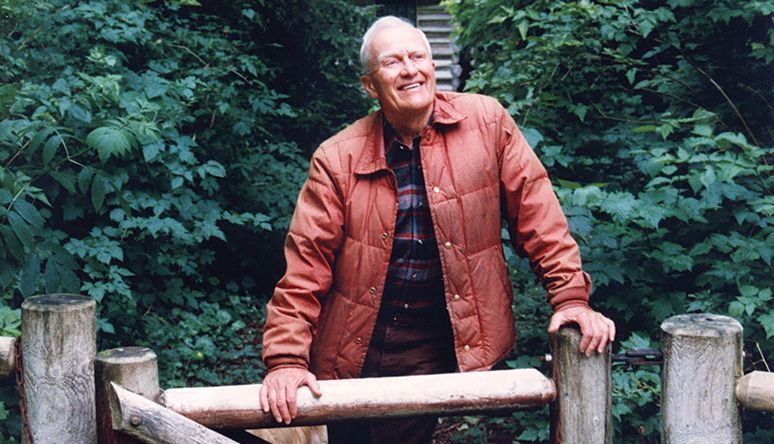
Jim Ellis, who more than anyone else shaped modern Seattle through his indefatigable civic actions, died at age 98 this past Monday. Ellis for decades set the pace and established the formula for Seattle’s emergence from a sleepy city to a bold metropolis. He saved Lake Washington, built a fine bus system, juiced downtown retail with visitors, and traded and cajoled his way to a Mountains-to-Sound Greenway.
Projectitis and all, Ellis had two powerful guiding principles: build urban density and save the greenbelts. As one who was always inspired by Ellis, allow me to pay tribute with two stories and one mild dissent
The first story is in the form of a witticism by another “Son of Jim,” the attorney Jerry Grinstein. Grinstein was a top administrative aide to Sen. Warren Magnuson (another mega-shaper of our town) and worked with Ellis on numerous civic-political-business projects. He took admiring measure of both titans.
With Maggie, as I recall Jerry’s observations, aides would brief him on a complex issue and Maggie would almost always jump immediately to the side of the issue that most benefited the public interest. And then would come the long period where the self-doubting Swedish side of Maggie would struggle to prevail, backing him away from his initial instinct. The role of staff was to keep Maggie in his instinctive mode, which usually happened.
By contrast, according the the Grinstein formulation, Ellis almost always jumped to the prudent, pragmatic, half-right position. The effort was to stall, give Ellis’s formidable political and legal mind time to think its way into the right stance — sometimes too late. An example was when Ellis, as a UW Regent, favored the demolition of the handsome complex of buildings on the Metropolitan Tract, the White-Henry-Stuart buildings. Wrong idea, in my view. And then Ellis rationalized this position by cooking up the idea of a pedestrian tunnel tying together the new building (the Rainier Tower) with the lovely old Skinner Building just east. Win-sorta-win solution, an Ellis trademark. Which he then drove to implementation with his famous tenacity. Tunnel and tower are still there.

My second story concerns Freeway Park, now called Jim Ellis Freeway Park (a rare occasion when backstage Jim allowed his name to be used). When I was head of Town Hall, adjacent to Freeway Park on First Hill, I got involved in improvements to the park, with help and inspiration from the elderly Ellis. One day he told me the story of how he wangled the park, a prime illustration of Ellis’s wily ways.
The story begins with a phone call from then-Mayor Dorm Braman, incensed at the abuse he was enduring from KING-AM radio host, the acid-tongued Irving Clark. This time, Braman was pushed over the edged, so he summoned his pal Ellis to the mayoral office. Braman was not going to take this media abuse anymore, so he was quitting as mayor, at once. Braman wanted Ellis, master fixer, to use his connections with the new Nixon White House, particularly John Ehrlichman, to get the ex-mayor a new job, namely transportation secretary.
Even the legendary Ellis couldn’t overcome Nixon’s promise of the job to Massachusetts Gov. John Volpe, but he did get Braman a deputy position, which Braman jumped at. Months pass, and Ellis gives Braman a call to ask how this impetuous act was working out. Badly. Volpe was incensed at not getting to name his own senior staff and so had frozen Braman out.
I imagine Ellis, the master improviser, as not missing a beat. He told Braman that he happened to have a project for him: Braman could focus on creating Freeway Park, right over I-5. Braman set about doing just that, even getting the park eligible for federal funds by defining much of it as a freeway ramp. Ellis twisted local arms, including developer Tony Callison, who was contemplating a building that would have blocked access to the park, Park Place. The office building was pivoted, Ellis picked Lawrence Halprin, the celebrated landscape architect he admired from the Auditorium Forecourt Park in Portland. And the internationally famous park was created. Someday it might spawn further lids over the Freeway gulch.
Such is the Ellis Treatment. Victories spread around. An underlying commitment to urban density (and fighting sprawl). Public-private juggernauts. Mayor of the shadow government, trusted by both political parties and business bigshots. Adored by the media editorial pages. Hands-on mastery of the details. And almost impossible to pull off today despite some excellent proteges. (Gerry Johnson, Gene Duvernoy, Marshall Foster, Matt Griffin, and Jack McCullough come to mind as illustrious Sons of Jim.)

As for my mild dissent? Seattle, perhaps inspired by Ellis’s example, suffers from “projectitis,” striking projects that are not really part of any larger, coherent plan. An example is Ellis’s determination to build the Convention Center downtown, right next to Freeway Park as it happens, as opposed to the alternative site at Seattle Center. Convention Centers are neutron bombs in cities – blank walls, needing to expand into an urban fabric, alienating to residents. Ellis was convinced by the hotels that having all those conventioneers right by their hotels would be an advantage. And so he got out his shoehorn and his ingenuity and created the big hulking thing, well up in the air (to accommodate the hillside) and so awkward to expand. (We are now expanding to a third site, two blocks away.) Someone needed to give Ellis more time to think his way into the right solution!
Thanks, Jim.
Discover more from Post Alley
Subscribe to get the latest posts sent to your email.
